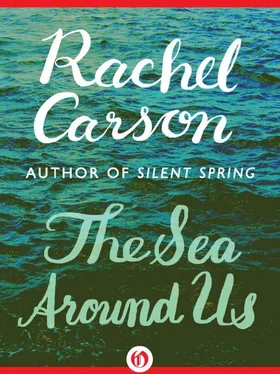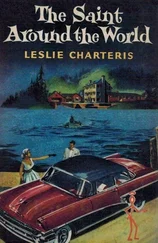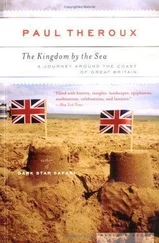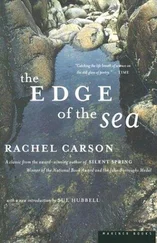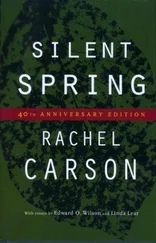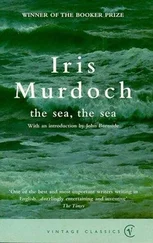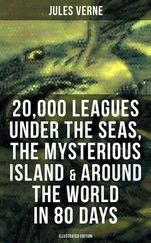The new earth, freshly torn from its parent sun, was a ball of whirling gases, intensely hot, rushing through the black spaces of the universe on a path and at a speed controlled by immense forces. Gradually the ball of flaming gases cooled. The gases began to liquefy, and Earth became a molten mass. The materials of this mass eventually became sorted out in a definite pattern: the heaviest in the center, the less heavy surrounding them, and the least heavy forming the outer rim. This is the pattern which persists today—a central sphere of molten iron, very nearly as hot as it was 2 billion years ago, an intermediate sphere of semiplastic basalt, and a hard outer shell, relatively quite thin and composed of solid basalt and granite.
The outer shell of the young earth must have been a good many millions of years changing from the liquid to the solid state, and it is believed that, before this change was completed, an event of the greatest importance took place—the formation of the moon. The next time you stand on a beach at night, watching the moon’s bright path across the water, and conscious of the moon-drawn tides, remember that the moon itself may have been born of a great tidal wave of earthly substance, torn off into space. And remember that if the moon was formed in this fashion, the event may have had much to do with shaping the ocean basins and the continents as we know them.
There were tides in the new earth, long before there was an ocean. In response to the pull of the sun the molten liquids of the earth’s whole surface rose in tides that rolled unhindered around the globe and only gradually slackened and diminished as the earthly shell cooled, congealed, and hardened. Those who believe that the moon is a child of Earth say that during an early stage of the earth’s development something happened that caused this rolling, viscid tide to gather speed and momentum and to rise to unimaginable heights. Apparently the force that created these greatest tides the earth has ever known was the force of resonance, for at this time the period of the solar tides had come to approach, then equal, the period of the free oscillation of the liquid earth. And so every sun tide was given increased momentum by the push of the earth’s oscillation, and each of the twice-daily tides was larger than the one before it. Physicists have calculated that, after 500 years of such monstrous, steadily increasing tides, those on the side toward the sun became too high for stability, and a great wave was torn away and hurled into space. But immediately, of course, the newly created satellite became subject to physical laws that sent it spinning in an orbit of its own about the earth. This is what we call the moon.
There are reasons for believing that this event took place after the earth’s crust had become slightly hardened, instead of during its partly liquid state. There is to this day a great scar on the surface of the globe. This scar or depression holds the Pacific Ocean. According to some geophysicists, the floor of the Pacific is composed of basalt, the substance of the earth’s middle layer, while all other oceans are floored with a thin layer of granite, which makes up most of the earth’s outer layer. We immediately wonder what became of the Pacific’s granite covering and the most convenient assumption is that it was torn away when the moon was formed. There is supporting evidence. The mean density of the moon is much less than that of the earth (3.3 compared with 5.5), suggesting that the moon took away none of the earth’s heavy iron ore, but that it is composed only of the granite and some of the basalt of the outer layers.
The birth of the moon probably helped shape other regions of the world’s oceans besides the Pacific. When part of the crust was torn away, strains must have been set up in the remaining granite envelope. Perhaps the granite mass cracked open on the side opposite the moon scar. Perhaps, as the earth spun on its axis and rushed on its orbit through space, the cracks widened and the masses of granite began to drift apart, moving over a tarry, slowly hardening layer of basalt. Gradually the outer portions of the basalt layer became solid and the wandering continents came to rest, frozen into place with oceans between them. In spite of theories to the contrary, the weight of geologic evidence seems to be that the locations of the major ocean basins and the major continental land masses are today much the same as they have been since a very early period of the earth’s history.
But this is to anticipate the story, for when the moon was born there was no ocean. The gradually cooling earth was enveloped in heavy layers of cloud, which contained much of the water of the new planet. For a long time its surface was so hot that no moisture could fall without immediately being reconverted to steam. This dense, perpetually renewed cloud covering must have been thick enough that no rays of sunlight could penetrate it. And so the rough outlines of the continents and the empty ocean basins were sculptured out of the surface of the earth in darkness, in a Stygian world of heated rock and swirling clouds and gloom.
As soon as the earth’s crust cooled enough, the rains began to fall. Never have there been such rains since that time. They fell continuously, day and night, days passing into months, into years, into centuries. They poured into the waiting ocean basins, or, falling upon the continental masses, drained away to become sea.
That primeval ocean, growing in bulk as the rains slowly filled its basins, must have been only faintly salt. But the falling rains were the symbol of the dissolution of the continents. From the moment the rain began to fall, the lands began to be worn away and carried to the sea. It is an endless, inexorable process that has never stopped—the dissolving of the rocks, the leaching out of their contained minerals, the carrying of the rock fragments and dissolved minerals to the ocean. And over the eons of time, the sea has grown ever more bitter with the salt of the continents.
In what manner the sea produced the mysterious and wonderful stuff called protoplasm we cannot say. In its warm, dimly lit waters the unknown conditions of temperature and pressure and saltiness must have been the critical ones for the creation of life from non-life. At any rate they produced the result that neither the alchemists with their crucibles nor modern scientists in their laboratories have been able to achieve.
Before the first living cell was created, there may have been many trials and failures. It seems probable that, within the warm saltiness of the primeval sea, certain organic substances were fashioned from carbon dioxide, sulphur, nitrogen, phosphorus, potassium, and calcium. Perhaps these were transition steps from which the complex molecules of protoplasm arose—molecules that somehow acquired the ability to reproduce themselves and begin the endless stream of life. But at present no one is wise enough to be sure.
Those first living things may have been simple microorganisms rather like some of the bacteria we know today—mysterious borderline forms that were not quite plants, not quite animals, barely over the intangible line that separates the non-living from the living. It is doubtful that this first life possessed the substance chlorophyll, with which plants in sunlight transform lifeless chemicals into the living stuff of their tissues. Little sunshine could enter their dim world, penetrating the cloud banks from which fell the endless rains. Probably the sea’s first children lived on the organic substances then present in the ocean waters, or, like the iron and sulphur bacteria that exist today, lived directly on inorganic food.
All the while the cloud cover was thinning, the darkness of the nights alternated with palely illumined days, and finally the sun for the first time shone through upon the sea. By this time some of the living things that floated in the sea must have developed the magic of chlorophyll. Now they were able to take the carbon dioxide of the air and the water of the sea and of these elements, in sunlight, build the organic substances they needed. So the first true plants came into being.
Читать дальше
